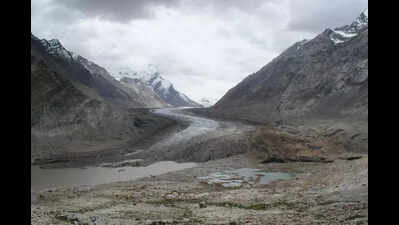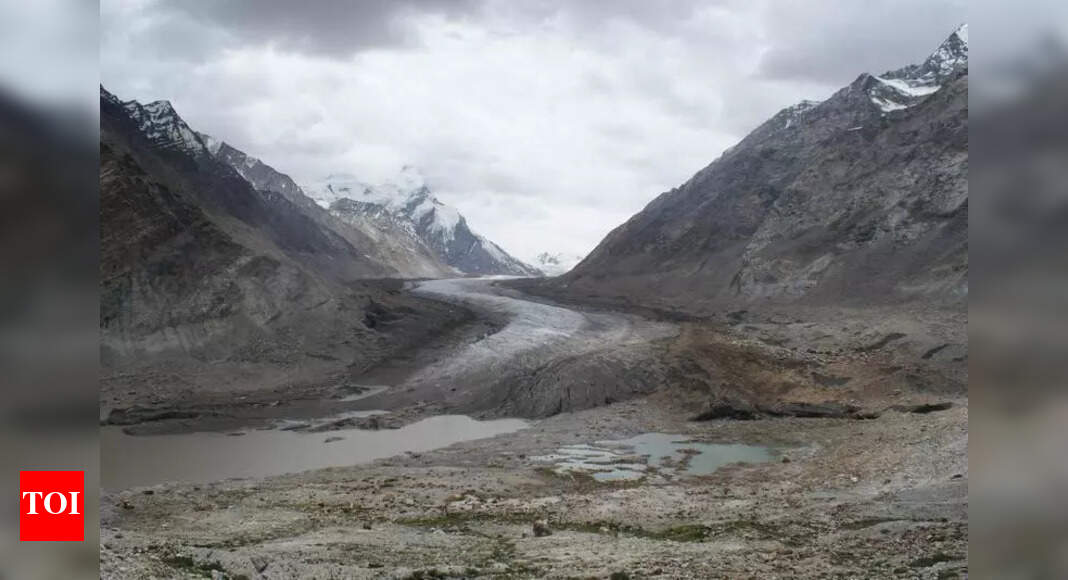 Dehradun: Mountain glaciers, long regarded as the natural coolers of the planet’s high-altitude environments, are rapidly losing their ability to shield themselves from atmospheric warming. A new global study published in Nature Climate Change journal warns that by the 2040s, most of the world’s glaciers will “recouple” with the warming atmosphere, accelerating melt rates and amplifying the impacts of climate change across mountain regions.The research team, led by Thomas E Shaw of the Institute of Science and Technology Austria, analysed 3.7 million hourly meteorological observations from 350 automatic weather stations across 62 glaciers worldwide. These glaciers span environments from the Himalayas and Andes to the Alps, Rockies, and New Zealand.The study found that the thin air layer above glaciers currently warms by only about 0.8°C for every 1°C rise in the surrounding atmosphere. This “temperature decoupling” occurs because the glacier surface cools the air above it through katabatic winds — downslope flows of cold, dense air generated over ice. Such winds create a microclimate that helps glaciers resist the full impact of global warming.However, as glaciers retreat and shrink in area, these stabilising winds weaken. By mid-century, shrinking ice bodies will lose the physical conditions needed to maintain this cooling layer, the study says. “Our analysis shows that glacier boundary layers, which once protected ice from warming, are breaking down,” said Shaw. “As this happens, glaciers will begin to warm almost as fast as the air around them.”Model projections under both moderate and high-emission climate scenarios indicate that this cooling effect will peak between the 2020s and 2040s, before reversing as ice loss accelerates. Under the worst-case scenario, up to 84% of the world’s 186,000 mountain glaciers could vanish by 2100. Even under moderate warming, around 68% are expected to disappear.The study revealed striking regional variations in how glaciers are responding to atmospheric warming. In South Asia, glaciers on the humid southern slopes of the Himalayas currently show stronger temperature decoupling, maintaining surface air temperatures roughly 2°C cooler than the surrounding atmosphere. However, researchers warn that this protective buffer is likely to diminish sooner in the Himalayas as debris cover thickens and glaciers continue to shrink in length, making this a worrying concern for countries like India.In contrast, glaciers in colder, high-altitude regions, such as the Karakoram and Central Andes, remain more thermally coupled with the atmosphere and are expected to warm at a slower pace. Meanwhile, in regions like New Zealand, Scandinavia, and western Canada, near-surface air above glaciers could warm by more than 3°C relative to the ice surface by the end of the century — signalling a rapid loss of the natural cooling effect that once moderated these environments.Beyond faster melt rates, researchers caution that this “recoupling” will disrupt mountain water cycles, alter precipitation patterns, and intensify hazards such as glacial lake outburst floods and summer droughts downstream. The decay of the glacier microclimate also means mountain regions could lose a natural cooling influence that has historically moderated local climates.The authors called for glacier and hydrological models to integrate this nonlinear response to warming, warning that traditional linear melt projections underestimate future ice loss. “Glaciers are not just victims of climate — they influence it,” said the study. “But as they vanish, their capacity to cool and stabilise mountain climates will disappear with them.”
Dehradun: Mountain glaciers, long regarded as the natural coolers of the planet’s high-altitude environments, are rapidly losing their ability to shield themselves from atmospheric warming. A new global study published in Nature Climate Change journal warns that by the 2040s, most of the world’s glaciers will “recouple” with the warming atmosphere, accelerating melt rates and amplifying the impacts of climate change across mountain regions.The research team, led by Thomas E Shaw of the Institute of Science and Technology Austria, analysed 3.7 million hourly meteorological observations from 350 automatic weather stations across 62 glaciers worldwide. These glaciers span environments from the Himalayas and Andes to the Alps, Rockies, and New Zealand.The study found that the thin air layer above glaciers currently warms by only about 0.8°C for every 1°C rise in the surrounding atmosphere. This “temperature decoupling” occurs because the glacier surface cools the air above it through katabatic winds — downslope flows of cold, dense air generated over ice. Such winds create a microclimate that helps glaciers resist the full impact of global warming.However, as glaciers retreat and shrink in area, these stabilising winds weaken. By mid-century, shrinking ice bodies will lose the physical conditions needed to maintain this cooling layer, the study says. “Our analysis shows that glacier boundary layers, which once protected ice from warming, are breaking down,” said Shaw. “As this happens, glaciers will begin to warm almost as fast as the air around them.”Model projections under both moderate and high-emission climate scenarios indicate that this cooling effect will peak between the 2020s and 2040s, before reversing as ice loss accelerates. Under the worst-case scenario, up to 84% of the world’s 186,000 mountain glaciers could vanish by 2100. Even under moderate warming, around 68% are expected to disappear.The study revealed striking regional variations in how glaciers are responding to atmospheric warming. In South Asia, glaciers on the humid southern slopes of the Himalayas currently show stronger temperature decoupling, maintaining surface air temperatures roughly 2°C cooler than the surrounding atmosphere. However, researchers warn that this protective buffer is likely to diminish sooner in the Himalayas as debris cover thickens and glaciers continue to shrink in length, making this a worrying concern for countries like India.In contrast, glaciers in colder, high-altitude regions, such as the Karakoram and Central Andes, remain more thermally coupled with the atmosphere and are expected to warm at a slower pace. Meanwhile, in regions like New Zealand, Scandinavia, and western Canada, near-surface air above glaciers could warm by more than 3°C relative to the ice surface by the end of the century — signalling a rapid loss of the natural cooling effect that once moderated these environments.Beyond faster melt rates, researchers caution that this “recoupling” will disrupt mountain water cycles, alter precipitation patterns, and intensify hazards such as glacial lake outburst floods and summer droughts downstream. The decay of the glacier microclimate also means mountain regions could lose a natural cooling influence that has historically moderated local climates.The authors called for glacier and hydrological models to integrate this nonlinear response to warming, warning that traditional linear melt projections underestimate future ice loss. “Glaciers are not just victims of climate — they influence it,” said the study. “But as they vanish, their capacity to cool and stabilise mountain climates will disappear with them.”

Glaciers losing their cooling edge: Global study warns of faster melting by mid-century | Dehradun News
- October 13, 2025
